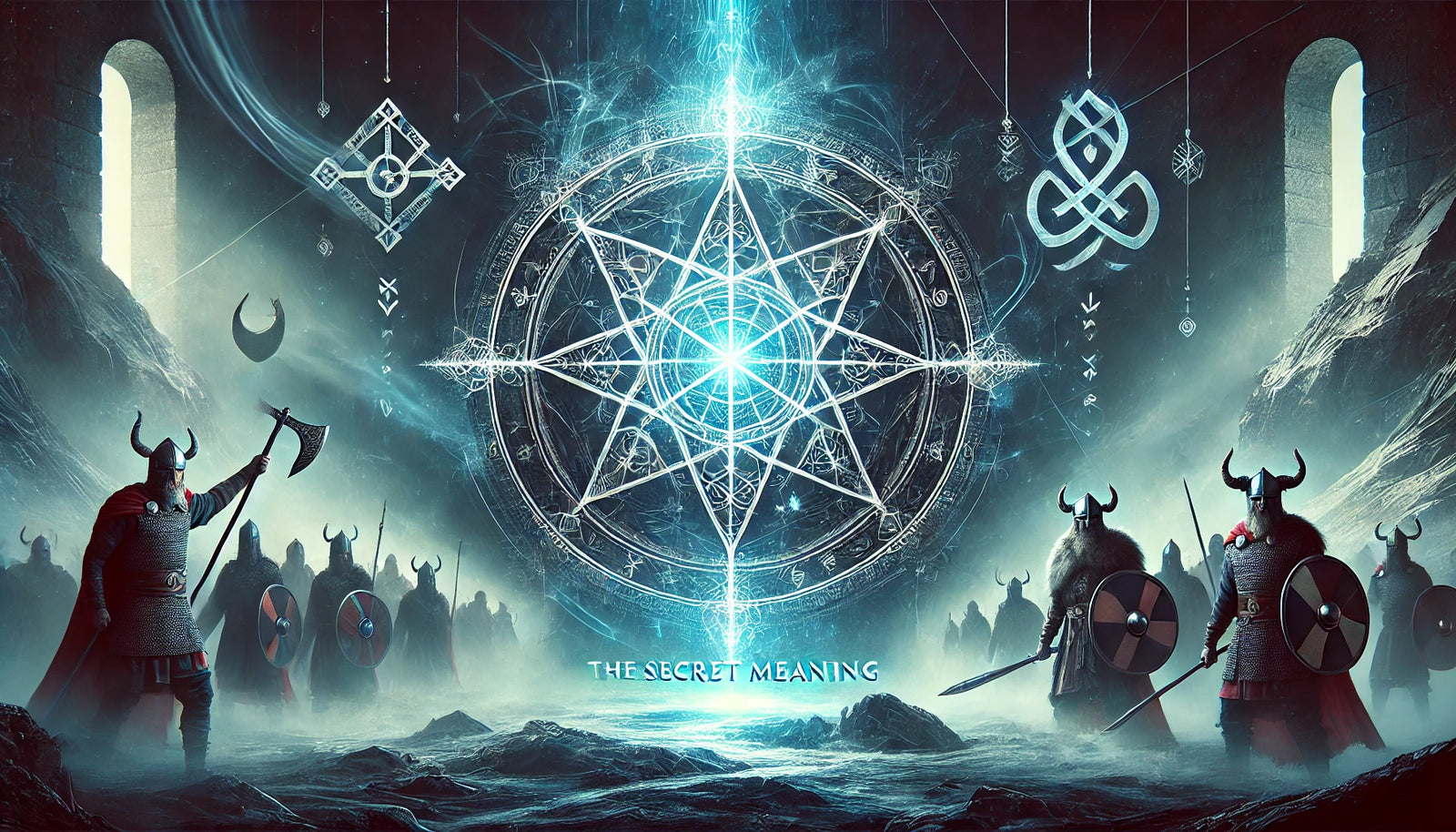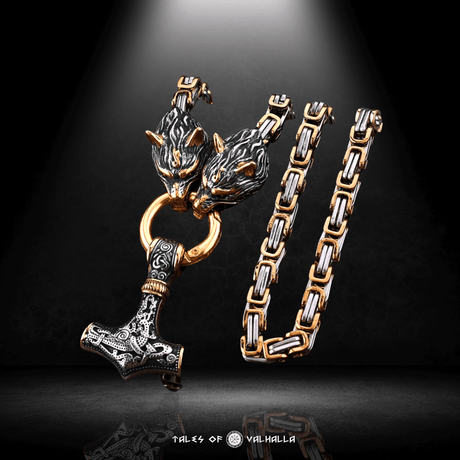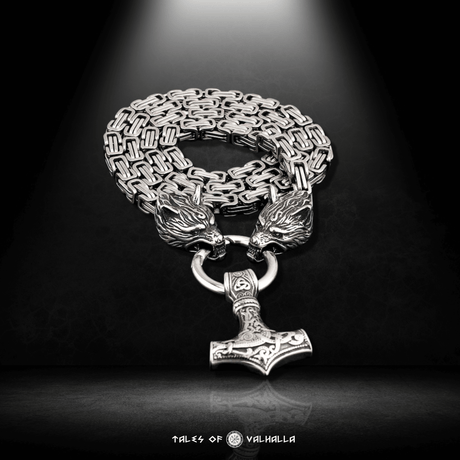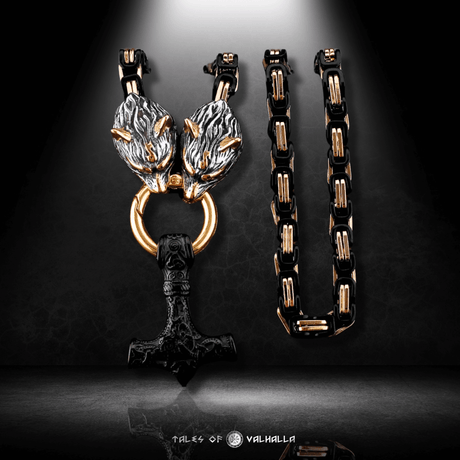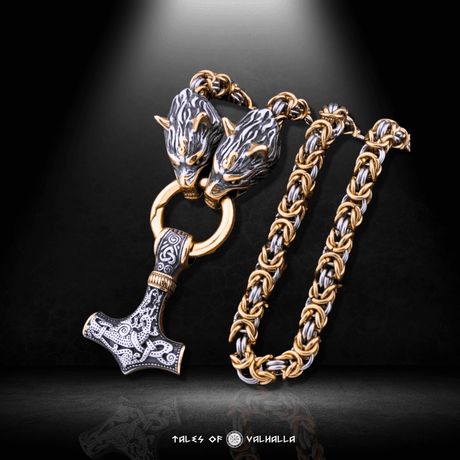The ancient Norse world is filled with symbols that carry deep meanings, invoking awe, reverence, and curiosity among those who explore them. One such symbol is Aegishjalmur, also known as the Helm of Awe. This powerful symbol has captivated the imagination of people for centuries, standing as a testament to the mysticism and strength that characterized the Viking era. In this blog, we delve into the origins, symbolic power, and modern interpretations of Aegishjalmur, revealing the secrets behind this enigmatic symbol.
The Origins of Aegishjalmur
What is Aegishjalmur?

What is Aegishjalmur?
Aegishjalmur, often referred to as the Helm of Awe, is a symbol steeped in Norse mythology and Viking tradition. Its name combines two Old Norse words: "aegis," meaning shield, and "hjalmr," meaning helm. The symbol typically consists of a central point with eight tridents radiating outward, resembling a wheel or a sunburst. Each trident is composed of runic shapes that are believed to invoke protection, power, and invincibility.
In Viking culture, Aegishjalmur was not just a symbol but a talisman, worn or inscribed on the body, weapons, or armor to imbue the wearer with the qualities of fearlessness and strength. The design of Aegishjalmur is simple yet profound, symbolizing the unity of physical and spiritual power that was essential for survival in the harsh and often brutal world of the Vikings.
Historical Context
The history of Aegishjalmur is closely tied to the warrior culture of the Norse people. The symbol is mentioned in various ancient texts, including the Poetic Edda and Prose Edda, where it is described as a powerful emblem used by warriors to strike fear into the hearts of their enemies. According to the sagas, the symbol was so potent that it could render a warrior invincible in battle, warding off danger and ensuring victory.
One of the most famous references to Aegishjalmur is found in the Fáfnismál, a part of the Poetic Edda, where the dragon Fafnir, who had hoarded a great treasure, claims to have used the Helm of Awe to protect himself and his wealth. This connection to Fafnir emphasizes the symbol's association with both physical and psychological dominance.
Artifacts bearing the Aegishjalmur symbol have been discovered in various parts of Scandinavia, further attesting to its widespread use among the Norse people. These findings suggest that the Helm of Awe was not just a literary or mythical construct but a real and tangible part of Viking life.
The Symbolic Power of Aegishjalmur
Protection and Fearlessness
At its core, Aegishjalmur is a symbol of protection and fearlessness. The Vikings believed that wearing or carrying the Helm of Awe would grant them the strength and courage needed to face their enemies without fear. This belief was not merely about physical protection but also about psychological empowerment.
The symbol was thought to have the power to manipulate the mind, both of the wearer and those who beheld it. For the wearer, it provided a sense of invulnerability, a mental shield that fortified them against fear and doubt. For opponents, it was believed to instill a deep sense of dread, weakening their resolve and making them more susceptible to defeat.
This dual function of Aegishjalmur as both a protective talisman and a psychological weapon made it an essential part of the Viking warrior's arsenal. It was not just about brute strength; it was about mastering the mind and using it as a tool for victory.
Connection to Norse Deities
Aegishjalmur is also deeply connected to the Norse pantheon, particularly the gods Odin and Tyr, who were revered for their wisdom, strategy, and martial prowess. Odin, the Allfather, was the god of war, wisdom, and magic, often depicted as a master of runes and symbols. Aegishjalmur, with its runic design and mystical properties, was likely seen as a manifestation of Odin's power.
Tyr, the god of law and heroic glory, was another deity associated with the Helm of Awe. Known for his unwavering courage and sense of justice, Tyr embodied the qualities that Aegishjalmur was believed to bestow upon its wearer. In this way, the symbol served as a bridge between the mortal and divine, connecting those who used it with the gods themselves.
In Norse mythology, symbols like Aegishjalmur were not merely decorative; they were believed to contain the essence of the gods, channeling their power into the world of men. This connection to the divine made Aegishjalmur more than just a tool for battle—it was a sacred emblem, a conduit for the forces that shaped the universe.
Modern Interpretations and Uses
Aegishjalmur in Modern Culture
In recent years, there has been a resurgence of interest in Norse mythology and Viking symbols, with Aegishjalmur playing a prominent role in modern culture. Today, the Helm of Awe is commonly used in tattoos, jewelry, and artwork, symbolizing strength, protection, and the enduring legacy of the Viking age.
Tattoos featuring Aegishjalmur have become especially popular, with many people choosing to ink the symbol on their bodies as a reminder of their own inner strength and resilience. The simplicity and symmetry of the design make it an ideal tattoo, while its rich history adds layers of meaning for those who choose to wear it.
In addition to tattoos, Aegishjalmur is often incorporated into jewelry, such as pendants, rings, and bracelets. These items are not just fashion accessories; they are expressions of a connection to the ancient past and a way to carry the protective power of the Helm of Awe in daily life.
Psychological and Spiritual Meanings
Beyond its physical representation, Aegishjalmur holds deep psychological and spiritual significance in the modern world. For many, it symbolizes the ability to overcome fear and adversity, to stand strong in the face of challenges, and to remain centered in times of turmoil.
From a psychological perspective, Aegishjalmur can be seen as a tool for mental fortitude. The act of wearing or visualizing the symbol can serve as a form of meditation, helping individuals to focus their minds and harness their inner strength. In this way, Aegishjalmur functions as a form of cognitive armor, protecting the mind from negative thoughts and external pressures.
Spiritually, the Helm of Awe represents a connection to the ancient wisdom of the Norse people, a link to the past that provides guidance and insight for the present. For those who follow modern pagan or spiritual practices, Aegishjalmur is a powerful symbol of protection and empowerment, a reminder that the strength of the gods is within reach.
How to Use Aegishjalmur in Everyday Life
Incorporating Aegishjalmur in Personal Rituals
If you're drawn to the symbolism of Aegishjalmur and want to incorporate it into your daily life, there are several ways to do so. One of the most effective methods is through personal rituals that focus on protection and empowerment.
For example, you might create a morning ritual where you visualize the Helm of Awe surrounding you like a shield, protecting you from negativity and giving you the strength to face the day. This simple practice can set a powerful intention, helping you to stay focused and resilient throughout your daily activities.
Another way to use Aegishjalmur is in meditation. By focusing on the symbol during meditation, you can channel its energy to enhance your mental clarity and inner strength. Whether you use it as a visual focus or trace its shape in the air, Aegishjalmur can become a potent tool for deepening your spiritual practice.
Aegishjalmur in Home Décor and Fashion
Aegishjalmur is not just for personal use; it can also be incorporated into your home and fashion choices as a way to keep its protective power close. Consider adding artwork or wall hangings featuring the Helm of Awe to your living space, where it can serve as a constant reminder of strength and protection.
In fashion, you might choose clothing or accessories that feature the symbol, such as a pendant, ring, or embroidered patch. These items can be worn daily to carry the energy of Aegishjalmur with you, offering a sense of security and empowerment wherever you go.
For those who wish to surround themselves with the power of the Helm of Awe, incorporating it into both personal rituals and physical surroundings can create a cohesive and meaningful experience, blending the ancient with the modern in a way that honors the past while empowering the present.
Debunking Myths and Misinterpretations
Common Misunderstandings about Aegishjalmur
Despite its widespread use and popularity, Aegishjalmur is often misunderstood, with various myths and misconceptions surrounding its meaning and usage. One common misunderstanding is that Aegishjalmur is purely a symbol of aggression or violence. While it was indeed used by warriors, its primary purpose was protection and mental fortification, not the promotion of violence.
Another misconception is that Aegishjalmur was a universal symbol among all Vikings. In reality, its usage was likely more localized, with different regions and clans having their own symbols and talismans. The idea that every Viking warrior wore Aegishjalmur is more of a modern romanticization than a historical fact.
Cultural Appropriation vs. Cultural Appreciation
As with any symbol deeply rooted in cultural history, there is a fine line between cultural appropriation and cultural appreciation. When using symbols like Aegishjalmur, it's essential to approach them with respect and understanding, acknowledging their origins and the people who created them.
Cultural appropriation occurs when a symbol or practice is taken out of its original context and used in a way that disrespects or diminishes its meaning. In contrast, cultural appreciation involves a genuine interest in and respect for the culture from which the symbol originates, with a desire to learn and honor its significance.
For those who wish to use Aegishjalmur in their lives, it's important to do so thoughtfully, recognizing its deep roots in Norse culture and mythology. By approaching the symbol with reverence and understanding, you can honor its legacy while integrating its power into your modern life.
Conclusion
Aegishjalmur, the Helm of Awe, is more than just an ancient symbol; it is a timeless emblem of protection, strength, and psychological fortitude. From its origins in Viking warrior culture to its modern interpretations, Aegishjalmur continues to inspire and empower those who connect with its powerful energy.
As we explore the rich history and meaning behind Aegishjalmur, we uncover not just a symbol but a profound connection to the past—a reminder that the strength of the gods and the wisdom of the ancients are never far from us. Whether through personal rituals, fashion, or home décor, Aegishjalmur offers a way to carry the protective power of the Helm of Awe into our daily lives, fortifying us against the challenges of the modern world.

